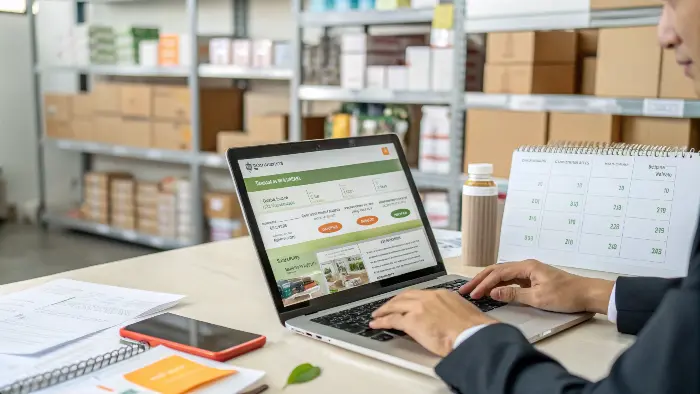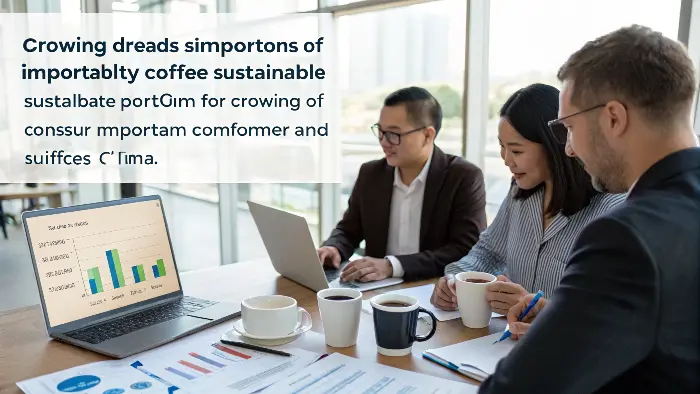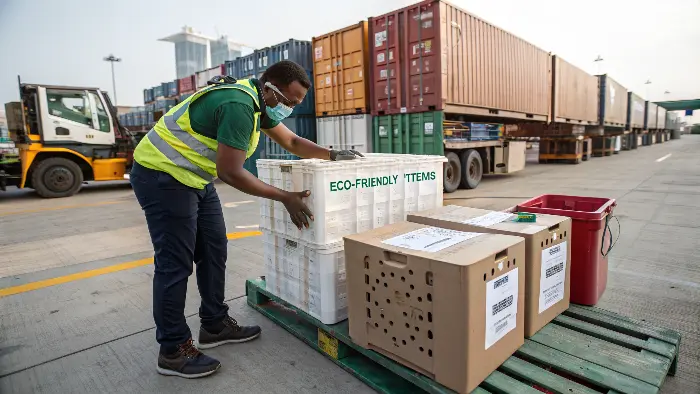Thinking of importing eco-friendly coffee shop gear from China but scared of the process? It seems complex, but with the right info, it’s totally doable. Let’s break it down.
Importing sustainable coffee shop supplies from China involves finding reliable suppliers, understanding regulations, navigating logistics, and ensuring product quality and eco-certifications. A clear strategy simplifies this seemingly daunting task, making it profitable and impactful.
So, you’re looking to stock up on sustainable coffee shop supplies – things like compostable cups, PLA lids, bagasse containers, maybe even those cool bamboo stirrers. And you’re thinking, "China’s the manufacturing hub, right?" You’re not wrong! I’ve spent years with Ecosourcecn building bridges between amazing Chinese manufacturers of eco-products and businesses worldwide, including folks like Jacky in Canada. The idea of importing directly can feel like a giant puzzle, especially when you add the "sustainable" layer. But honestly, once you get the hang of the key steps, it’s not so scary. It’s about being prepared, asking the right questions, and maybe having a good partner. Let’s walk through this.
How Do I Actually Import Supplies From China, Step-by-Step?
Feeling lost about the basic import process from China? You’re not alone! Many businesses find it intimidating initially. But, let’s demystify the core steps to get you started.
To import supplies from China, you’ll need to identify your product, find a reliable supplier, negotiate terms, arrange payment, handle shipping and customs clearance, and ensure compliance with your country’s import regulations.
Okay, so you’ve decided you want to import. What now? It’s not like just ordering something off Amazon, that’s for sure! When I first got into this business with Ecosourcecn, it felt like learning a new language. But it boils down to a sequence of actions. Think of it as a roadmap.
First, get your business basics in order. In most countries, you’ll need to be a registered business to import commercially. Check if you need an import license or number. For example, in the US, you might need an Importer of Record number, which can be your business’s EIN or SSN. Jacky, up in Canada, would have to check with the CBSA (Canada Border Services Agency).
Then, it’s about the actual import flow:
- Product Specification: Be crystal clear about what you want. For sustainable supplies, this means specifying materials (PLA, CPLA, bagasse, FSC paper), certifications (ASTM D6400, EN 13432), dimensions, and quality standards. The more detail, the better.
- Supplier Sourcing & Vetting: We’ll cover finding suppliers more in a bit, but once you have potentials, vet them thoroughly. Ask for business licenses, certifications, and ideally, factory audit reports if you’re looking at large volumes.
- Negotiate Terms (Incoterms are Key!): This is crucial. You’ll negotiate price, payment terms (often a deposit and balance before shipping), and Incoterms. Incoterms (like FOB, EXW, CIF) define who is responsible for what during shipping – costs, risks, insurance. For example:
- EXW (Ex Works): You handle all shipping costs and risks from the factory door.
- FOB (Free On Board): The supplier gets the goods to the port of export. You take over from there. This is super common.
- CIF (Cost, Insurance, Freight): The supplier pays for shipping and insurance to your chosen port. You handle import customs and delivery from your port.
I usually recommend FOB for more control, but it depends on your experience.
- Payment: Usually, it’s a Telegraphic Transfer (T/T). Many suppliers ask for 30% upfront and 70% before shipping or upon presentation of the Bill of Lading. Using services like Alibaba Trade Assurance can add a layer of security.
- Shipping & Logistics: You’ll likely use a freight forwarder. They are lifesavers! They handle booking space on ships/planes, manage documentation, and can guide you through customs.
- Customs Clearance: This involves submitting necessary documents (commercial invoice, packing list, bill of lading, certificates of origin, and any specific import permits or eco-certifications) and paying duties and taxes. Your freight forwarder usually handles this.
It seems like a lot, but take it one step at a time. And honestly, for sustainable products, that "Product Specification" and "Supplier Vetting" part is extra critical to avoid greenwashing.How Do I Find Eco-Friendly Products to Import From China?
Struggling to locate genuinely sustainable coffee shop supplies in the vast Chinese market? Finding the right products and trustworthy suppliers is key. So, where do you even begin looking?
Find sustainable products by using B2B platforms like Alibaba (filter for certified suppliers), attending virtual/physical trade shows focusing on eco-products, or partnering with specialized sourcing agents or platforms like Ecosourcecn who pre-vet suppliers.

This is where the "sustainable" part of your sourcing journey really comes into focus. It’s one thing to find any supplier in China; it’s another to find one that reliably produces genuinely eco-friendly coffee shop supplies. I’ve seen so many businesses get excited by low prices only to find out the "compostable" cups aren’t certified or the "bamboo" products are mixed with plastics. So, how do you find the good stuff?
- Online B2B Platforms:
- Alibaba: It’s the giant, no doubt. You can find almost anything. The trick is to use filters effectively. Look for "Verified Suppliers," "Trade Assurance," and check how long they’ve been on the platform. Critically, search for suppliers who explicitly mention certifications like BPI, TÜV Austria (for EN 13432), or adherence to ASTM D6400. Don’t just trust the listing; always ask for copies of these certificates and verify them. I spend a lot of time doing this!
- Made-in-China.com / Global Sources: Similar to Alibaba, these platforms also list many manufacturers. The same diligence applies.
- Specialized Eco-Product Sourcing Platforms (Like Us!): Shameless plug again, but this is Ecosourcecn’s bread and butter. We specialize in connecting businesses with pre-vetted Chinese manufacturers of eco-friendly products. We’ve already done a lot of the initial groundwork on certifications and supplier reliability for things like PLA utensils, bagasse containers, and compostable bags. This can save you a ton of time and reduce risk. For someone like Jacky, who needs specific eco-credentials, this is a huge advantage.
- Trade Shows (Physical & Virtual):
- Canton Fair: One of the largest trade fairs in the world, held in Guangzhou. Many suppliers showcase new products here, including eco-friendly options.
- Industry-Specific Shows: Look for packaging fairs or shows focused on sustainable products in China or Hong Kong. These days, many also have virtual components, which is great.
- Referrals & Networks: If you know other businesses already importing, ask for recommendations. Sometimes, the best leads come from trusted contacts.
- Direct Outreach (More Advanced): If you identify a specific type of product or material, you might research leading manufacturers in that niche and contact them directly. This requires more effort but can lead to strong partnerships.
When you find a potential supplier, communication is key. Ask detailed questions about their materials, production processes, and especially their certifications. If they’re hesitant to share details or certificates, that’s a red flag for me. A good supplier of genuine eco-products is usually proud to show their credentials.Is Importing Sustainable Coffee Supplies Actually Profitable?
Wondering if going green with imported coffee supplies will actually boost your bottom line? It’s a fair question! Profitability hinges on several factors beyond just the purchase price.
Yes, importing sustainable coffee supplies can be profitable due to growing consumer demand, potential for premium branding, and competitive manufacturing costs in China. However, profits depend on smart sourcing, efficient logistics, and understanding all associated costs.

This is the million-dollar question, isn’t it? Or at least, the question that keeps business owners up at night! The simple answer is: Yes, it absolutely can be profitable. But – and it’s a big but – it depends on how you approach it. I’ve seen clients at Ecosourcecn build very successful businesses around imported sustainable supplies, and I’ve also seen others struggle.
Here’s what influences profitability:
- Strong Market Demand: This is a huge plus. Consumers and businesses (like coffee shops) are increasingly demanding sustainable options. This isn’t just a fad; it’s a long-term shift. This demand allows for potentially better margins compared to conventional, less eco-friendly products. Jacky’s role as a Packaging Specialist for an eco-conscious brand is a testament to this trend.
- Product Differentiation & Branding: Offering genuinely sustainable, certified products allows you to differentiate yourself. Coffee shops can use this as a selling point, and distributors can position themselves as leaders in green supply. This can command a better price.
- Competitive Manufacturing Costs in China: Generally, China offers competitive manufacturing costs for many goods, including eco-friendly items made from materials like PLA, bagasse, and bamboo. This is a primary driver for importing.
- BUT, Consider All Costs (The "Landed Cost"): This is where people sometimes slip up. The factory price is just one part. You need to calculate your "landed cost," which includes:
- Product cost (EXW or FOB price)
- Shipping (ocean or air freight)
- Insurance
- Customs duties and taxes (these vary by product and country)
- Port fees, handling fees, and any inspection fees
- Inland transportation from your port to your warehouse
- Certification costs (if you’re pursuing your own or need specific verification)
For example, let’s say a PLA cup costs $0.05 EXW. After shipping, duties (e.g., 5-10%), and other fees, the landed cost might be $0.08-$0.10. You need to know this to price correctly.
- Quality and Reliability: Sourcing high-quality, consistently reliable products is crucial. Defective goods or items that don’t meet eco-claims can destroy your reputation and profitability. This is why vetting suppliers and certifications is non-negotiable.
- Efficient Logistics: Choosing the right shipping methods and freight forwarders can significantly impact costs. Wasted money on inefficient shipping eats directly into profits.
So, while the potential is there, profitability in importing sustainable coffee supplies from China requires due diligence, careful cost calculation, and a focus on quality. It’s not just about finding the cheapest option; it’s about finding the best value that aligns with your brand and your customers’ expectations.How Do I Get My Eco-Friendly Items Shipped From China?
Okay, you’ve found your sustainable coffee supplies and a great supplier in China. Now, how do you actually get those goods across the ocean and to your doorstep? Shipping can seem complex!
To get items shipped from China, choose a shipping method (sea or air), work with a freight forwarder to handle logistics and documentation, understand Incoterms, and prepare for customs clearance in your country.

This part – logistics – often feels like the most mysterious part of importing for newcomers. But once you understand the players and the process, it’s manageable. At Ecosourcecn, we handle global logistics for our clients, so I’ve learned a thing or two about making this smooth.
Here’s the lowdown on getting your sustainable coffee shop supplies from the factory in China to your warehouse:
- Choose Your Shipping Method:
- Sea Freight: This is the most common and cost-effective method for bulkier goods like coffee cups, lids, and containers. It’s slower (can take weeks), but the per-unit cost is much lower than air. You’ll typically ship either:
- FCL (Full Container Load): You book a whole container (20ft or 40ft). Best for larger orders.
- LCL (Less than Container Load): Your goods share container space with other importers’ goods. Good for smaller orders, but per-unit cost can be a bit higher than FCL, and there’s a slightly higher risk of damage if not packed well.
- Air Freight: Much faster (days instead of weeks) but significantly more expensive. Best for small, high-value shipments, urgent orders, or samples. For most sustainable coffee shop supplies, which tend to be relatively low-cost and bulky, sea freight is usually the way to go.
- Sea Freight: This is the most common and cost-effective method for bulkier goods like coffee cups, lids, and containers. It’s slower (can take weeks), but the per-unit cost is much lower than air. You’ll typically ship either:
- Work With a Freight Forwarder: I can’t stress this enough – a good freight forwarder is your best friend in international shipping! They are logistics experts who will:
- Book space on ships or planes.
- Advise on the best shipping routes.
- Prepare and manage shipping documents (Bill of Lading, packing list, commercial invoice).
- Arrange cargo insurance.
- Handle customs clearance at both ends (export from China, import to your country).
- Arrange inland transportation from the port to your final destination.
You can find freight forwarders online, through referrals, or sometimes your supplier might recommend one (though it’s good to get your own quotes too).
- Understand Your Incoterms (Again!): As mentioned before, Incoterms (FOB, CIF, EXW, etc.) dictate who pays for which part of the shipping and who bears the risk. If you’re on FOB terms, your supplier gets the goods to the Chinese port, and your freight forwarder takes over from there.
- Documentation is Key: Ensure all your paperwork is accurate and complete. This includes the commercial invoice, packing list, Bill of Lading (for sea) or Air Waybill (for air), and any required certificates (like Certificate of Origin, or specific eco-certifications like BPI or TÜV Austria conformity documents if your customs authorities require them for "eco" claims). Errors here can cause major delays and extra costs. I once saw a shipment held up for weeks because of a typo on a commercial invoice – frustrating!
- Customs Clearance: Your freight forwarder will usually act as your customs broker. They’ll submit the necessary declaration and paperwork to your country’s customs agency and let you know the duties and taxes payable.
- Tracking & Patience: Once your goods are on their way, you’ll get tracking information. Be prepared for potential delays – weather, port congestion, customs inspections can happen. Build some buffer time into your plans.
Shipping from China might seem like a big hurdle, but by choosing the right method and partnering with a reliable freight forwarder, you can get your sustainable coffee shop supplies delivered efficiently.Conclusion
Importing sustainable coffee supplies from China is achievable and profitable with research, reliable partners, and attention to detail. Focus on genuine eco-products and smooth logistics for success.


